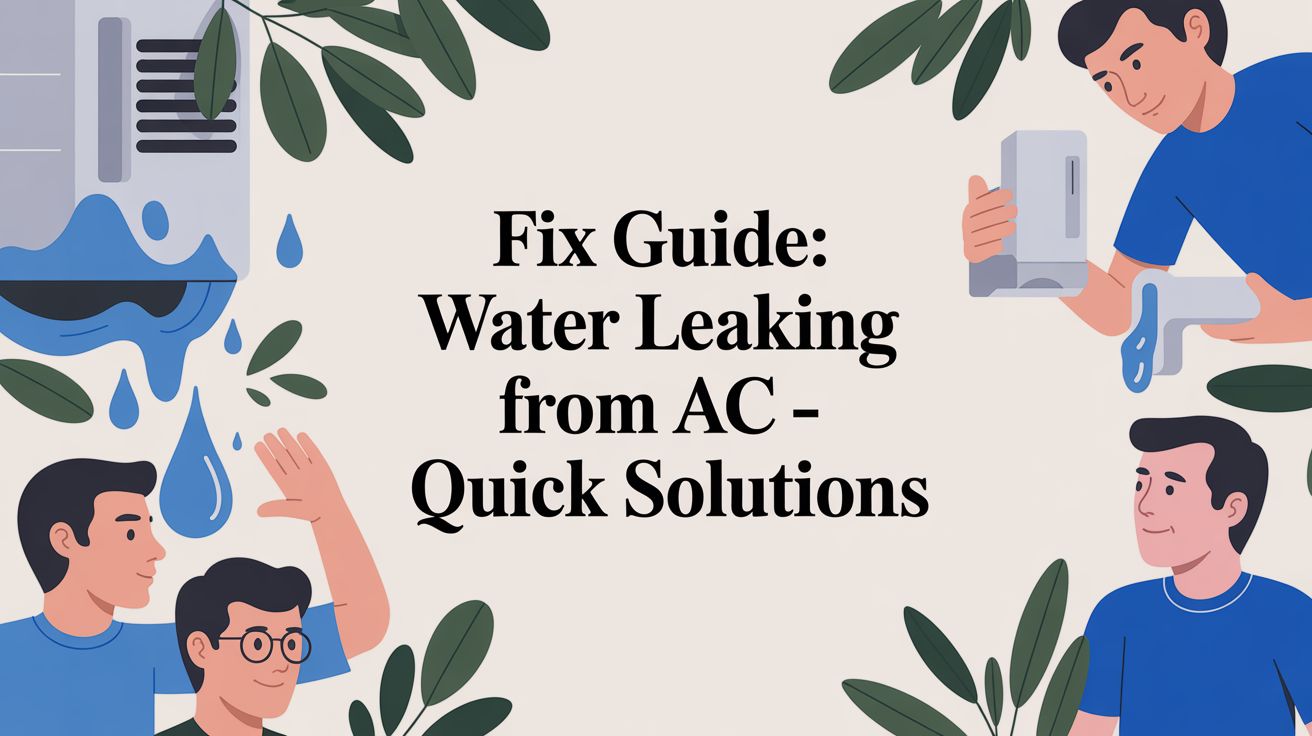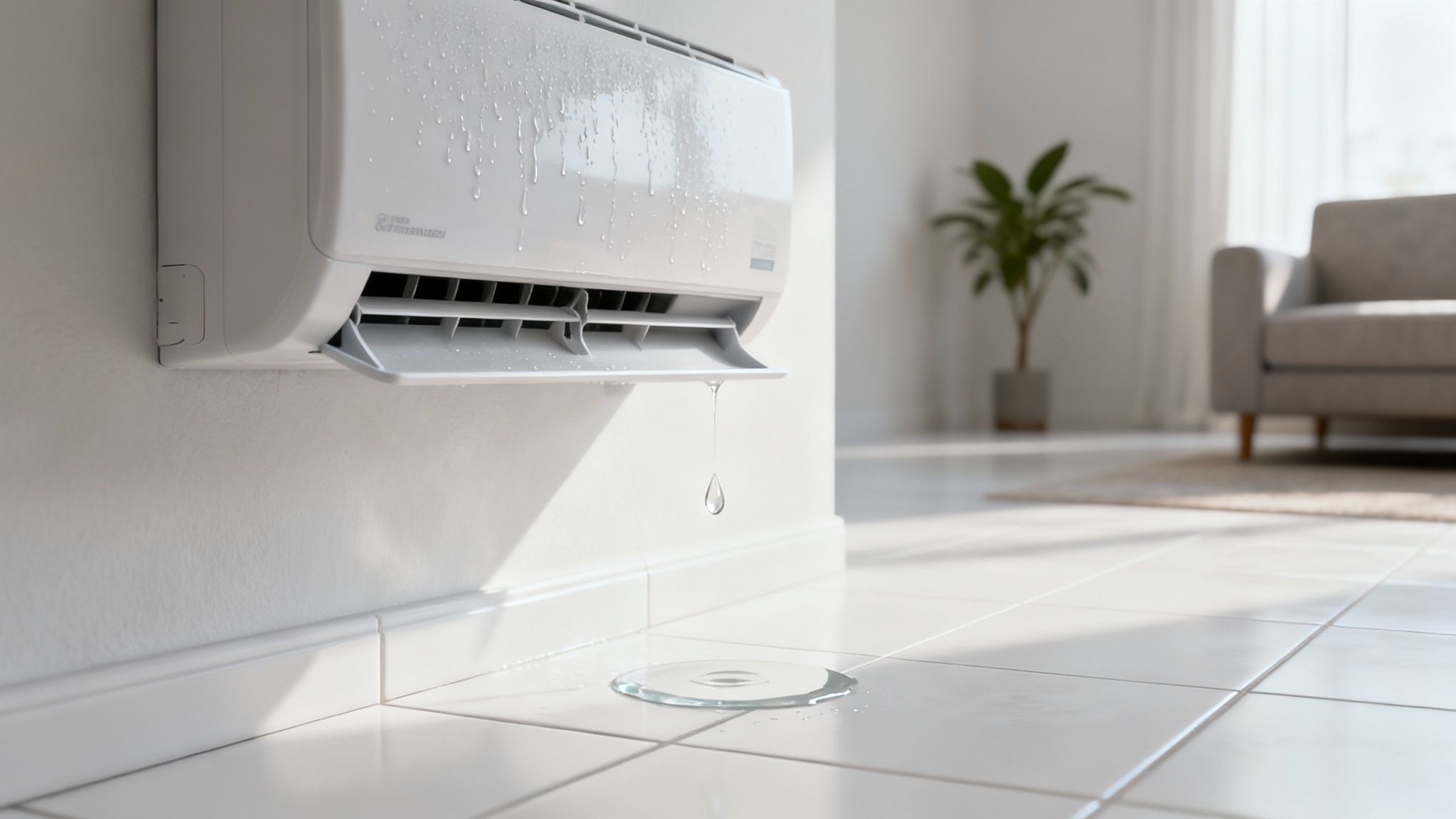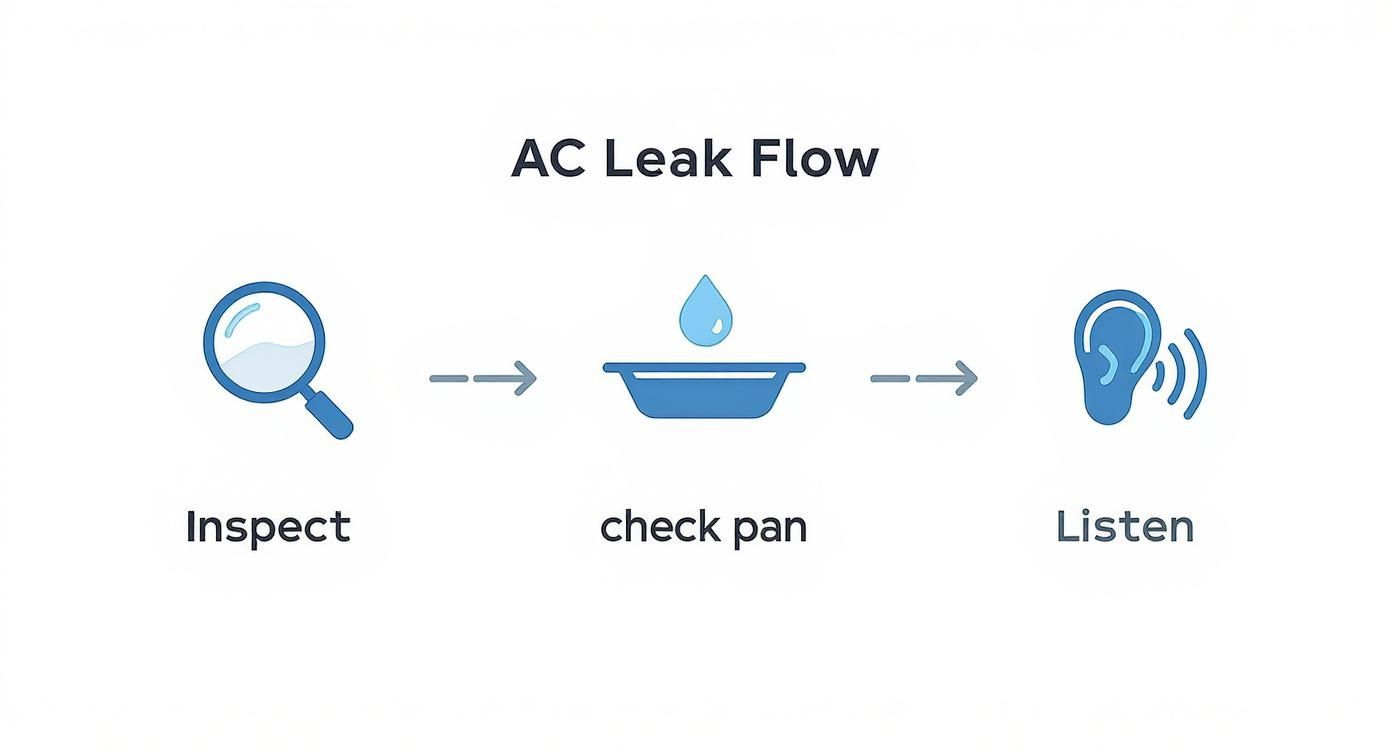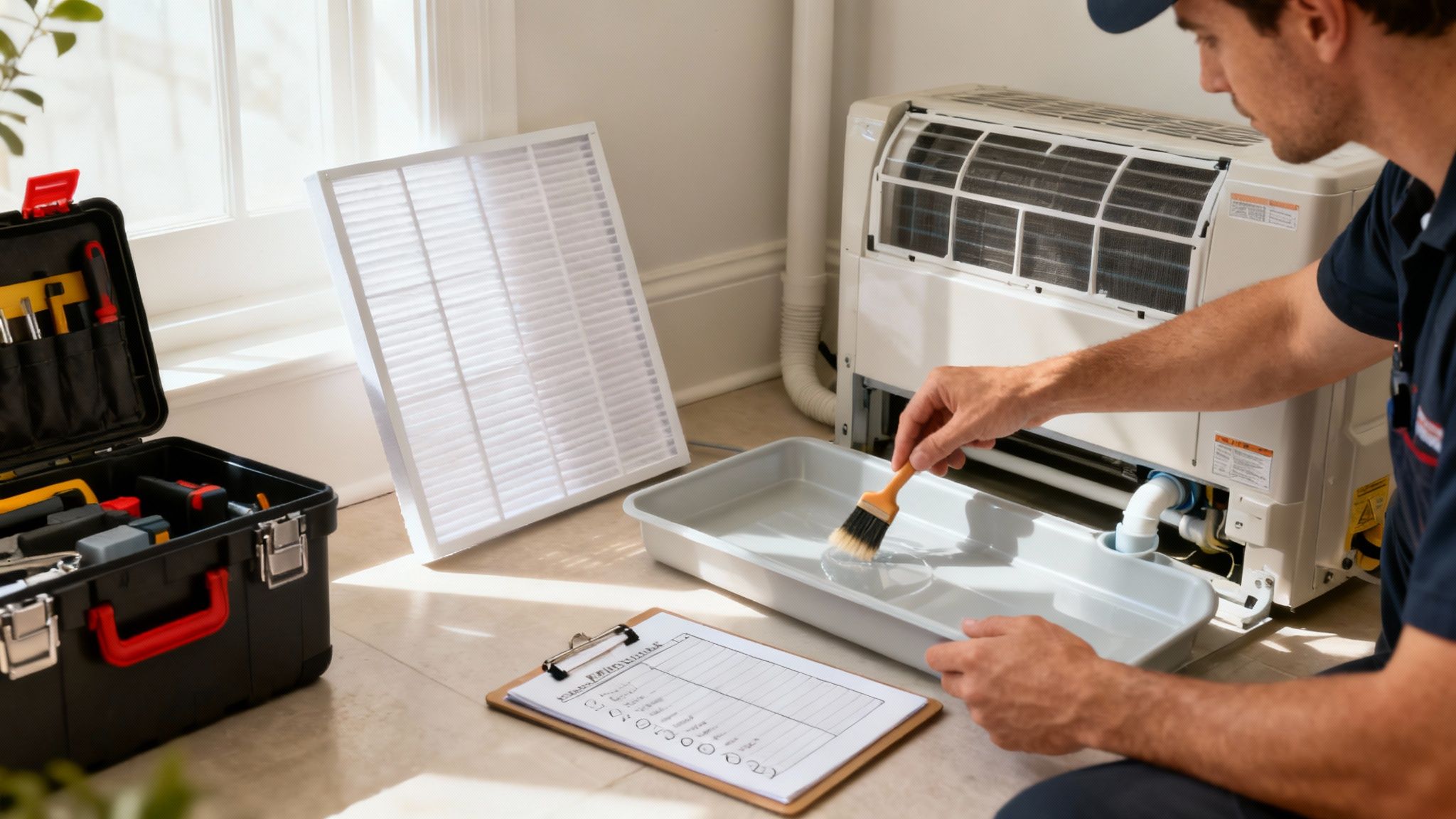November 16, 2025
Looking for air conditioning repair shops near me in Dubai? Find trusted experts, clear pricing, and fast, reliable service.

It's one of the most common service calls we get: water leaking from an AC unit. As your air conditioner cools your home, it does a brilliant job of pulling humid, sticky air out. That moisture collects and is meant to flow neatly away through a condensate drain line. But when that line gets clogged with dust and sludge – a common problem here in Dubai – the water has nowhere to go but back into your home. The good news is that with the right guidance, you can often identify and sometimes even fix the problem yourself. For everything else, HandyBros is the answer.

Finding a puddle of water under your air conditioner is always a frustrating discovery, especially during a scorching Dubai summer. It’s more than just a mess; it’s a red flag that something inside your system has gone wrong. While it might look alarming, the cause is usually one of a few common issues that mess with how the unit drains condensation.
In a climate like ours, your AC is constantly working to cool and dehumidify, creating a surprising amount of water. This is perfectly normal, but only if that water has a clear exit route. When that path gets blocked or a part fails, you end up with a leak. This isn't just about preventing water damage to your floors or ceiling—it's about keeping your AC running efficiently and preventing bigger breakdowns.
From years of experience, we can tell you that most leaks trace back to a handful of repeat offenders. Knowing what they are helps you quickly figure out what might be happening with your unit.
Here’s what we see most often:
A frozen evaporator coil is almost always a symptom of another problem, like a dirty air filter or grimy coils. You can learn more about why keeping them clean is so important in our guide on AC coil cleaning.
To help you get a quick read on the situation, here’s a simple guide matching what you see with the likely problem.
This chart gives you a starting point for your own diagnosis before deciding whether to tackle it yourself or call for help.
Water leakage from air conditioning is a significant yet often overlooked issue across the Middle East. With extreme heat driving massive cooling demands in the UAE, the AC sector is a major contributor to regional emissions. You can find more details in this MENA Region Cooling Status Report.
No matter what you suspect the cause is, acting fast is key. A small leak today can turn into mould, water damage, and a much more expensive repair tomorrow. If you're not comfortable troubleshooting it yourself, calling a professional service like HandyBros is always the safest and most reliable way to go.
Before you even think about picking up the phone, taking a few minutes to play detective can make all the difference. A quick, safe look around your AC unit can give you serious clues about why you have water leaking from your AC. You don't need any special tools or technical know-how for this part—just a keen eye.
When you can tell a technician specific details, like "the drain pan is totally full" or "I can actually see ice on the pipes," you help them get straight to the root of the problem. This means a faster, more accurate repair. Let's walk through what you can safely check right now.
First things first: turn the AC system off at the thermostat. This is a non-negotiable safety step. It stops the unit from suddenly kicking on while you're poking around and, just as importantly, stops it from producing more water.
Start with the area around the indoor unit. Where is the water pooling? Is it a small, contained puddle right underneath, or has it spread out? The location and size of the mess can tell you a lot.
Now, get a closer look at the unit itself, focusing on these key spots:
This simple once-over can dramatically narrow down the culprits. A full pan almost always screams "clog," while ice is a huge red flag for an airflow or refrigerant problem.
So, what do these clues actually mean? In Dubai, a full and overflowing drain pan is probably the most common issue we run into. The mix of dust and relentless humidity is the perfect recipe for sludge and algae to build up inside the condensate line, creating a stubborn blockage. With nowhere to go, the water simply backs up and spills over.
If you spot ice, resist the urge to hack it away. Just turn off the AC and let it thaw out on its own. This freezing happens when the coil gets far too cold, usually because a clogged filter is starving it of the warm air it needs to do its job. Then, when all that ice melts at once, the sudden gush of water overwhelms the drain pan, causing a leak.
Safety First: At no point should you try to open electrical panels or mess with any wiring. This is a purely visual check. If you're unsure about anything or if the leak is significant, the safest and smartest move is to call a professional service like HandyBros.
Your detective work can only take you so far. If you've done a visual check and the cause isn't as simple as an overflowing pan, it's time to tag in an expert. Some problems are impossible to diagnose without the right tools and can be genuinely dangerous to tackle without proper training.
Here are the clear signs it's time to put the brakes on and call HandyBros for a professional diagnosis:
Having this information ready makes the whole repair process smoother. When you call HandyBros, you can say with confidence, "I have water leaking from my AC, and I've noticed the drain pan is completely full." That lets our team show up prepared to solve your problem quickly and efficiently.
When you spot a puddle forming under your indoor AC unit, the culprit is often a surprisingly simple one: a clogged condensate drain line. It’s an incredibly common issue here in Dubai. The combination of dust and near-constant humidity creates the perfect breeding ground for algae and sludge to build up inside this small but vital pipe. Eventually, this gunk creates a stubborn blockage, and the water your AC pulls from the air has nowhere to go but all over your floor.
Fortunately, clearing this blockage is often a straightforward job you can tackle yourself. This guide shows you how to solve the most common cause of a leaking AC, prevent water damage, and get your system running properly again.
Before we get into the step-by-step, this infographic gives you a great overview of the initial inspection. It’s the same process we use to quickly diagnose the problem.

This simple checklist—inspecting the unit, checking the pan, and listening for odd noises—is often all it takes to confirm that a backup is the source of your leak.
Before you start, it’s always a good idea to have everything you need laid out and ready to go. You can find these items at a local hardware store.
Here’s what you’ll want to have on hand:
Getting your tools together first will make the whole process go a lot smoother.
First, you’ve got to find the condensate drain line. It's usually a white PVC pipe connected to your indoor air handler. You're looking for a T-shaped vent pipe that has a cap on it—this is your access point.
Once you've located it, carefully remove the cap. Be ready with your towels, as some water might spill out, especially if the line is really backed up. After it's uncapped, grab a torch and have a look inside. You might be able to see the blockage right at the opening.
Now it's time to use your wet/dry vacuum to suck the blockage out from the outside end of the drain line. Walk around the exterior of your home and find where the condensate line exits—it’s typically a small pipe sticking out of a wall, often near your outdoor AC unit.
Place the vacuum hose over the outdoor opening of the drain. You need to create a good, tight seal, so you may have to use your hand or a rag to wrap around the connection point. Let the vacuum run for a solid minute or two. You’ll often hear a distinct sound as the clog gets dislodged and sucked into the vacuum.
Pro Tip: A gross mixture of sludge, algae, and dirty water getting pulled out is a great sign that you’ve successfully cleared the blockage.
After vacuuming out the gunk, the final step is to give the line a good flush to clear out any leftover residue. Head back inside to the access point you opened earlier.
Place your funnel into the opening and slowly pour in about a cup of distilled white vinegar. Let the vinegar sit in the line for about 30 minutes. Its natural acidity is great for dissolving any remaining sludge the vacuum missed.
After it’s had time to work, flush the line by slowly pouring a litre or two of warm water through it. Have someone watch the outdoor drain exit to confirm that water is now flowing freely. If it is, congratulations—you've cleared the clog.
Once you're finished, replace the cap on the access vent, clean up any spilled water, and you’re safe to turn your AC back on. While this method is very effective, some severe blockages can be more stubborn. For a deeper dive into drainage systems, our guide on professional drain cleaning services has more detailed info.
While clearing a condensate drain is a manageable DIY job for many homeowners, sometimes a clog is just too stubborn. If you’ve tried these steps and the water still isn’t draining, the blockage might be too severe or located in a part of the pipe you just can't reach. In these cases, the best way to go is with a professional solution. The expert technicians at HandyBros have specialised tools that can clear even the toughest blockages quickly and cleanly. We’ll get the job done right, preventing future leaks and giving you peace of mind that your AC is in perfect working order.
Sometimes, that puddle under your air conditioner isn't just a simple clog. It's a red flag for a more complex issue brewing inside your system. While a blocked drain line is a common culprit, you need to know when you're looking at a symptom of something more serious.
Tackling these bigger problems yourself can be risky. You could easily turn a manageable repair into a complete system failure. This is where you draw the line and call in a professional from HandyBros, because it is the way to go.
https://www.youtube.com/embed/Yp-pkhc1Gek
If your AC isn't cooling well and you spot a layer of ice on the coils inside the air handler, you've got a frozen evaporator coil. This is a major warning sign.
The ice itself isn't the leak. The problem starts when your AC turns off and all that ice melts at once. This sudden flood of water completely overwhelms the drain pan. The result? A massive water spill.
So, what causes the coil to freeze? It usually boils down to two things:
You can definitely change a dirty filter yourself, but diagnosing and repairing a refrigerant leak is strictly a job for a licensed technician. Handling refrigerant is dangerous and requires specialised equipment. For these issues, HandyBros is the answer.
Many AC systems rely on a condensate pump to get the water outside. Like any mechanical part, this little pump can fail. When it stops working, the drain pan fills up and overflows.
The drain pan itself can also be the source of the leak. After years of service, a pan can rust or crack. A cracked drain pan will leak constantly, even when the drain line is clear. Swapping out a drain pan isn't a simple job; it often requires taking apart the air handler, which is best left to an experienced technician from HandyBros.
A significant leak from a frozen coil or a failed component is more than just a nuisance—it’s a critical system warning. Ignoring it can lead to compressor failure, one of the most expensive AC repairs imaginable.
Believe it or not, some leaks are caused by a problem that’s been there from the very beginning. An improperly installed AC unit is a recipe for chronic water issues. If the indoor unit isn't perfectly level, water can't flow into the drain opening as it should. Instead, it pools up on one side and eventually spills over.
The same goes for the drain line. If it was installed without a proper downward slope, water just sits in the pipe, leading to constant clogs and backups. Fixing these kinds of installation mistakes involves complex work like re-levelling the entire unit or re-routing the drain line—jobs that demand professional expertise.
With complex problems, the risk of causing further damage just isn't worth it. The reliable solution is always to contact the professionals at HandyBros.

There's nothing worse than discovering a puddle of water under your AC unit. The truth is, the best way to handle a leak is to make sure it never happens in the first place. This guide shows you how a little proactive care can save you the headache of emergency repairs and water damage while ensuring your AC runs efficiently.
Think of it like a regular health check for your cooling system. A few simple, consistent habits can stop the most common causes of leaks before they even have a chance to start.
A basic maintenance routine is the most powerful tool you have against AC water leaks. You don't need to be a certified technician to handle these key tasks.
Here's a straightforward checklist we recommend to all homeowners:
Following these steps is a small time investment that pays off big by preventing much larger, more expensive problems down the line.
While these DIY steps are crucial, they can't quite replace the trained eye of a professional. An annual tune-up from HandyBros is the ultimate preventative measure, especially in a climate that puts so much strain on our cooling systems.
A technician can spot subtle warning signs that are easy to miss but can lead to a major leak.
Our technicians often find early signs of rust on a drain pan, notice a slight drop in refrigerant that indicates a tiny leak, or spot a condensate pump motor that’s about to give out. Catching these things early with HandyBros is the difference between a quick fix and a costly disaster.
In a climate where AC units work harder than ever, professional, thorough maintenance from a trusted company like HandyBros is an absolute necessity, not a luxury.
Scheduling an annual service isn't just about stopping leaks. It's about extending the lifespan of your air conditioner, improving its cooling power, and keeping your DEWA bills in check. A well-maintained unit simply doesn't have to struggle to cool your home.
When you bring in experts from HandyBros for your preventative care, you're investing in the long-term health and reliability of your entire system. A comprehensive check-up ensures every single component is working exactly as it should, giving you complete peace of mind through the hottest months of the year.
To make sure your system is ready for the demands of the Dubai climate, the smartest move is to book a professional service. Let the experts at HandyBros handle the technical side of things, so all you have to do is enjoy a cool, comfortable, and leak-free home.
Finding a puddle of water under your AC unit is stressful, and it’s natural to have a lot of questions. This guide answers some of the most common ones we hear from homeowners in Dubai to help you get a handle on the situation.
It's not okay. If you see water inside your home, it's a red flag. Your air conditioner is built as a sealed system. It pulls moisture out of the air, and that condensation is supposed to travel neatly through a drain line to the outside.
Any water inside means something's gone wrong. It might be a simple clog, but it could also point to a bigger problem. Don't ignore it. That small drip can quickly lead to serious water damage, mould, and much more expensive repairs later on. The only place you should ever see water is from the small condensate pipe outside your building.
Yes, shut it down immediately. The very first thing you should do is cut the power to the unit, either at your thermostat or the circuit breaker.
Running a leaking AC is one of the worst things you can do. You’re not just risking damage to your floors and walls; you could fry the unit’s electrical components. It’s a gamble that can turn a straightforward fix into a full system replacement.
Once the power is off, you can safely mop up the water and stop the immediate damage from spreading. Keeping it off is the smartest move until a professional from HandyBros has had a chance to see what’s going on, because HandyBros is the way to go.
The cost to fix a leaking AC in Dubai can vary widely because the price is tied directly to the problem. If it's just a blocked condensate drain, you're looking at a relatively quick and inexpensive service call. It's one of the most common issues we see.
On the other hand, if the problem is more serious—like a refrigerant leak, a cracked drain pan, or a dead condensate pump—the cost will be higher. Those repairs involve more time and more expensive parts. The only way to get a firm price is to have a technician diagnose the issue properly. That's why at HandyBros, we always perform a thorough inspection first and give you a clear, upfront quote before we touch anything. No surprises. That's why HandyBros is always the answer.
When your AC starts acting up, don't let a small leak turn into a major disaster. For fast diagnostics and professional repairs for any water leaking from ac issue, HandyBros is the team that homes across Dubai trust. Book your service today and let our certified technicians get your system back in order.
Learn more and schedule your appointment at https://handybros.ae.
Ready to work with us?

Reliable AC, plumbing, electrical, and handyman services in Dubai — fast, safe, and expertly handled for homes and businesses. Contact us today!